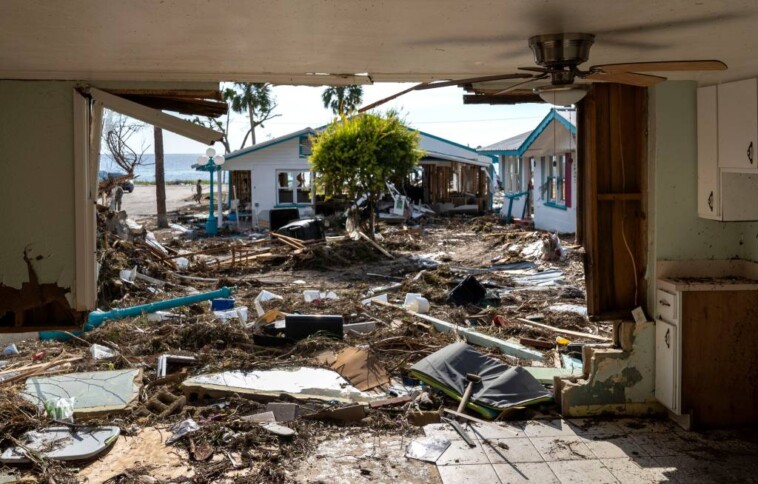Hurricane Helene dissipated Saturday, but massive rains brought by the storm have left many people stranded and without power as cleanup began from the monster tempest that killed scores of people and caused billions of dollars in destruction across a wide swath of the Southeast.
At least 133 deaths have been confirmed.
September 26, Evening
Florida
- Category 4 Hurricane Helene made landfall onshore of Florida’s Big Bend on the evening of September 26. The storm touched down near Perry, Florida, just east of the mouth of the Aucilla River.
- Winds were sustained at 140 mph with gusts to 155 mph in the eye wall of this storm.
- The hurricane killed at least 13 people.
- Helene’s “fierce” and “unstoppable” storm surge has left some homes in Florida completely obliterated and “just rubble,” Florida Gov. Ron DeSantis said at a news conference Saturday.
September 27, Morning
South Georgia
- Hurricane Helene was downgraded to a Category 1 storm upon making landfall in South Georgia and then became a tropical storm.
- The area’s sustained wind speed slowed to 70 mph. At this point, life-threatening winds, flash flooding, rain, and storm surges are ongoing throughout Florida, Georgia, North Carolina, and South Carolina.
- Georgia Gov. Brian Kemp told reporters at a press conference in Augusta that the storm “literally spared no one.” Most people in and around Augusta, a city of about 200,000 people near the South Carolina border, were still without power Monday, reports WABE.
- Helene moved northeast into Georgia, where it was downgraded to a tropical storm by Friday morning, but winds and floods left 25 dead in the state.
September 27, Afternoon
North Carolina
- Mandatory evacuations were in place for some residents of Asheville in western North Carolina as “catastrophic rain” caused severe flooding in the region—over 100 people had to be rescued, according to Gov. Roy Cooper.
- In Asheville, North Carolina, a total of 13.98 inches (35.52 centimeters) of rain fell from September 25 to 27, according to National Weather Service.
- At least 40 people died in the Asheville area, and a tornado injured 15 in Rocky Mount and 600 people remain unaccounted for in Buncombe County, North Carolina, which encompasses Asheville.
- “We’re doing the best we can,” Buncombe County Sheriff Quentin Miller said of conditions making it almost impossible to reach the stranded due to collapsed roads, failing infrastructure and widespread flooding.
- Later on, Helene moved over to parts of Tennessee, Virginia, North Carolina, and South Carolina.

September 27, Evening
Tennessee
- Dangerous floodwaters quickly surrounded Tennessee’s Unicoi County Hospital and seeped inside the building; many inside could no longer be safely evacuated and were forced to relocate to the roof, according to the hospital.
- Reports reveal that 73 remain unaccounted for in Unicoi County, TN.
- Although the heavy rain passed, many parts of northeast Tennessee remained flooded, its Emergency Management Agency posted on X Saturday. “All roads should be considered potentially hazardous,” it warned.
September 28, Aftermath
- Helene’s “fierce” and “unstoppable” storm surge has left some homes in Florida completely obliterated and “just rubble,” Florida Gov. Ron DeSantis said at a news conference Saturday.
- Over 200 people were rescued from the North Carolina floods.
- “This is obviously a catastrophic event, historic. People in western North Carolina say they have never seen anything like it. Our priority right now is to get people out and to get supplies in,” North Carolina Gov. Roy Cooper told MSNBC. “A lot of people are still stranded.”
September 30
West Virginia, Virginia, and Maryland
- There is an elevated flood threat on Monday in Virginia and West Virginia. The already saturated ground could receive an additional 1 to 2 inches of rain, which could produce flash flooding.
- Over the weekend, rescuers struggled to clear roads and recover bodies. The death toll is 132 and counting, and as many as 600 remain missing.
October 1, Morning
Here’s how the electric outages stand as of 10 a.m. ET, according to the United States power outage map.
- South Carolina: 616,000+
- Georgia: 460,000+
- North Carolina: 371,000+
- Virginia: 72,000+
- Florida: 68,000+
Although Hurricane Helene has eased down, trouble is brewing in the Gulf Coast as another tropical disturbance develops.
A “large, disorganized area” of low pressure in the Western Caribbean Sea is producing conditions that could lead to a 40% chance of tropical disturbance development over the next week, according to the National Hurricane Center.








